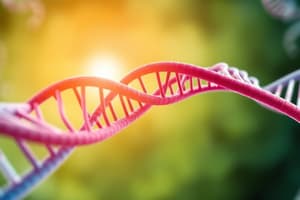Podcast
Questions and Answers
What is the primary role of RNA Polymerase II in eukaryotes?
What is the primary role of RNA Polymerase II in eukaryotes?
- Synthesizes tRNAs
- Synthesizes most mRNAs (correct)
- Synthesizes all types of RNA
- Synthesizes most rRNAs
What feature distinguishes polycistronic mRNA in prokaryotes?
What feature distinguishes polycistronic mRNA in prokaryotes?
- Contains multiple genes coding for proteins (correct)
- Contains information for only one polypeptide
- Requires multiple promoters for transcription
- Requires a single transcription factor
What initiates transcription in eukaryotic cells?
What initiates transcription in eukaryotic cells?
- Transcription factors (correct)
- Rho factors
- Introns
- Sigma factors
What mechanism does Rho-dependent termination involve?
What mechanism does Rho-dependent termination involve?
Which statement about the genetic code is accurate?
Which statement about the genetic code is accurate?
What is a common characteristic of intrinsic terminators?
What is a common characteristic of intrinsic terminators?
What type of RNA carries the genetic message after introns have been removed?
What type of RNA carries the genetic message after introns have been removed?
How do prokaryotic cells differ from eukaryotic cells in terms of transcription initiation?
How do prokaryotic cells differ from eukaryotic cells in terms of transcription initiation?
In prokaryotes, how are genes related to metabolic pathways typically organized?
In prokaryotes, how are genes related to metabolic pathways typically organized?
What does a promoter do in the context of transcription?
What does a promoter do in the context of transcription?
What is the primary function of DNA binding proteins in transcriptional control?
What is the primary function of DNA binding proteins in transcriptional control?
In transcriptional control, what is the role of a repressor?
In transcriptional control, what is the role of a repressor?
Which of the following defines an inducible pathway?
Which of the following defines an inducible pathway?
What is the function of a corepressor in bacterial regulatory proteins?
What is the function of a corepressor in bacterial regulatory proteins?
Which type of transcriptional control would involve the binding of an activator to an activator binding site?
Which type of transcriptional control would involve the binding of an activator to an activator binding site?
What does transcriptional repression involve?
What does transcriptional repression involve?
What characterizes a repressible pathway?
What characterizes a repressible pathway?
What is the role of an inducer in gene regulation?
What is the role of an inducer in gene regulation?
Which of the following statements about allosteric DNA binding proteins is correct?
Which of the following statements about allosteric DNA binding proteins is correct?
What is the main difference between negative and positive control in transcription?
What is the main difference between negative and positive control in transcription?
Flashcards are hidden until you start studying
Study Notes
Transcription Unit
- In prokaryotes, the transcription unit can contain multiple genes, resulting in polycistronic mRNA.
- These genes often code for enzymes involved in the same metabolic pathway.
Eukaryotic Transcription
- Eukaryotes have three types of RNA polymerases: RNA Polymerase I, II, and III.
- Each polymerase is responsible for producing a specific type of RNA, such as rRNA, mRNA, or tRNA.
- Transcription in eukaryotes is controlled by transcription factors instead of sigma factors.
Eukaryotic RNA Processing
- Eukaryotic mRNA undergoes post-transcriptional modification.
- This process includes capping, splicing, and polyadenylation.
Transcription Termination in Prokaryotes
- Rho-independent termination relies on specific DNA sequences called inverted repeats, which form hairpin structures in the RNA.
- Rho-dependent termination requires the Rho protein, which binds to a specific site on the RNA and then moves towards the RNA polymerase.
Messenger RNA
- Messenger RNA (mRNA) carries genetic information from DNA to the ribosomes.
- In eukaryotes, mRNA undergoes splicing to remove introns and leave the coding exons.
The Genetic Code
- The genetic code is a set of rules that determines how the sequence of nucleotides in DNA or RNA codes for the sequence of amino acids in proteins.
- It is expressed in terms of codons, three nucleotide sequences.
- Each codon specifies a particular amino acid.
Translation
- Translation is the process by which the genetic code in mRNA is used to synthesize a protein.
- This process occurs at the ribosomes.
Gene Regulation
- Gene regulation refers to the control of gene expression, which can occur at different levels.
- These levels include transcriptional, translational, and post-translational.
- Constitutive genes are expressed at a constant level, while regulated genes are expressed only when needed.
Transcriptional Control
- Transcriptional control often involves DNA-binding proteins that recognize specific sequences in DNA.
- These proteins act as either repressors or activators.
- Repressors decrease gene expression by binding to operators, while activators increase gene expression by binding to activator binding sites.
Inducible and Repressible Pathways
- Inducible pathways are typically turned off and are activated by the presence of a substrate.
- Repressible pathways are typically turned on and are repressed by the presence of a product.
Bacterial Regulatory Proteins
- Bacterial regulatory proteins are often allosteric, meaning they can bind to both DNA and effector molecules.
- Inducers prevent repressors from binding to DNA, while corepressors activate repressors, allowing them to bind to DNA.
Studying That Suits You
Use AI to generate personalized quizzes and flashcards to suit your learning preferences.




